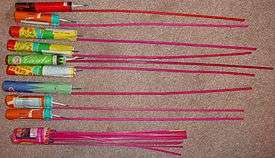Bottle rocket

A bottle rocket is a small skyrocket. A typical bottle rocket consists of a rocket engine attached to a stabilizing stick. The user can place the stick in an empty bottle (hence the name) and ignite the rocket engine; the mouth of the bottle guides the stick, stabilizing the rocket in its first moments of flight. In India, bottle rockets are set off during the Hindu festival of Diwali, and are sold in the millions.
These rockets have been made at least since the early decades of the 20th century, and in many countries, including Japan, China, and Macao. The older type of bottle rocket was typically a black powder skyrocket with an engine about 2 inches (5 cm) long and up to 0.375 inch (9 mm) diameter, mounted on a thin bamboo splint and often having a small report charge.
Modern bottle rockets are small and very cheap. They are often sold by the box (but more commonly by the gross, a packet of 144 rockets) for less than $US 0.20 each. In Thailand's Isan region, many are made by hand and sold in conjunction with Rocket Festivals. The largest bottle rockets used at the festivals are Bang Fai rockets which can be up to 20 metres long and charged with up to 500 kg of black powder.[1][2]
Countries
Bottle rockets are specifically illegal in many jurisdictions, even those where most other consumer fireworks are legal. They are sometimes considered to present a unique hazard, due to their ability to fly in many directions other than vertically.
Bottle rockets are authorized under the Explosives Act, thus making importation, possession, transportation, storage or manufacturing illegal in Canada.[3]
Bottle rockets are illegal in several states in the USA, but they are cheap and very easy to obtain.
Construction
A bottle rocket consists of three major parts including:
- The rocket engine. This will typically use a black powder-type fuel, possibly with additives to produce a decorative spark trail as the rocket ascends, but they have also used other chemical reactions for thrust. The fuel is pressed to form a solid grain inside a cardboard Lub tube; this tube is sealed at the top, but open at the bottom with an air gap. When the fuel is ignited from the bottom, hot gases expand in the air gap giving it an upward motion. The expanding air is then expelled downwards, propelling the rocket upwards. Other fuels are possible. A common alternative choice is whistle mix, to produce a whistling rocket.
- The nose cone. In addition to serving its aerodynamic role, the nose cone typically contains the rocket's payload. This may include exploding fireworks, colored stars, a parachute, confetti, or other decorative items.
- The guide stick. A typical bottle rocket, with no fins or other stabilizers, relies entirely on its stick for stability in flight. The stick's length and weight are chosen to achieve this.
See also
- Water rocket, a model rocket propelled by water and compressed air, sometimes referred to as a "bottle rocket" as they are often constructed from soda bottles.
References
- ↑ Wilhelm Klein; John Gottberg; Hans Hoefer (1987). Burma. APA Productions.
- ↑ Joshua Eliot; Jane Bickersteth (2003). Thailand Handbook. Footprint Handbooks. ISBN 1903471540.
- ↑ Authorization Guidelines for Consumer and Display Fireworks